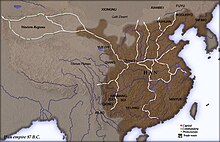
Back Ухуан Bulgarian Wuhuan Catalan Wuhuan German Wuhuan French 烏桓 Japanese Ухуань Kazakh 오환 Korean Vuhuanai Lithuanian Ухуань Mongolian Wuhuan NB


The Wuhuan (simplified Chinese: 乌桓; traditional Chinese: 烏桓; pinyin: Wūhuán, < Eastern Han Chinese: *ʔɑ-ɣuɑn, < Old Chinese (c. 78 BCE): *ʔâ-wân < *Awar[1]) were a Proto-Mongolic[2][3] or para-Mongolic[4] nomadic people who inhabited northern China, in what is now the provinces of Hebei, Liaoning, Shanxi, the municipality of Beijing and the autonomous region of Inner Mongolia.
- ^ Schuessler, Axel (2014) "Phonological Notes on Hàn Period Transcriptions of Foreign Names and Words" in Studies in Chinese and Sino-Tibetan Linguistics: Dialect, Phonology, Transcription and Text. Series: Language and Linguistics Monograph. Issue 53. p. 257 of 249-292
- ^ Pulleyblank, Edwin G. (1983). "The Chinese and Their Neighbors in Prehistoric and Early Historic China," in The Origins of Chinese Civilization, University of California Press, p. 452 of pp. 411–466.
- ^ Kradin N. N. (2011). "Heterarchy and hierarchy among the ancient Mongolian nomads". Social Evolution & History. 10 (1): 188.
The ancient Mongolian nomads – the Wuhuan and Xianbei – migrated in the late centuries BC – first centuries AD mainly in the territory of Inner Mongolia, as well as, partially, in the neighboring geographic areas.
- ^ Shimunek, Andrew (2017). Languages of Ancient Southern Mongolia and North China: a Historical-Comparative Study of the Serbi or Xianbei Branch of the Serbi-Mongolic Language Family, with an Analysis of Northeastern Frontier Chinese and Old Tibetan Phonology. Wiesbaden: Harrassowitz Verlag. ISBN 978-3-447-10855-3. OCLC 993110372.